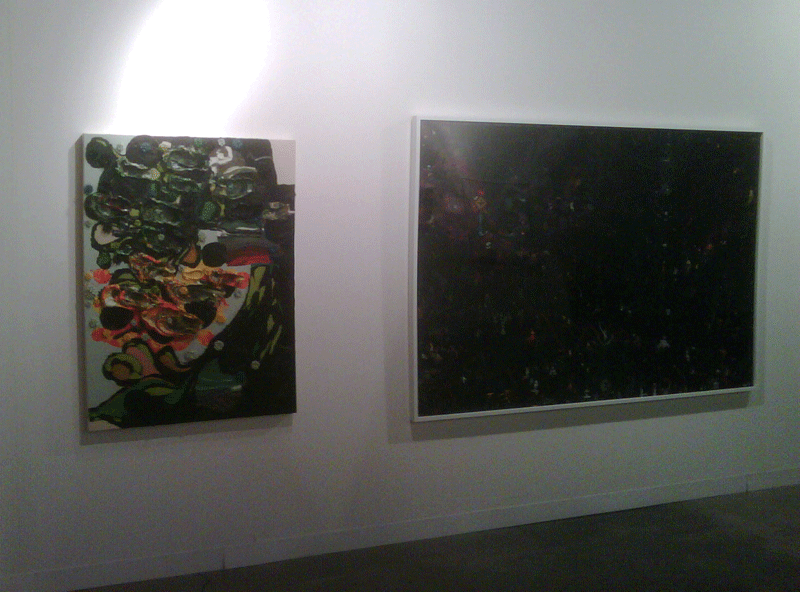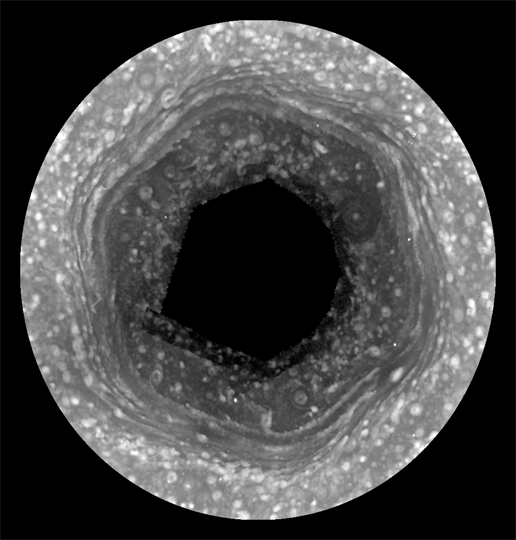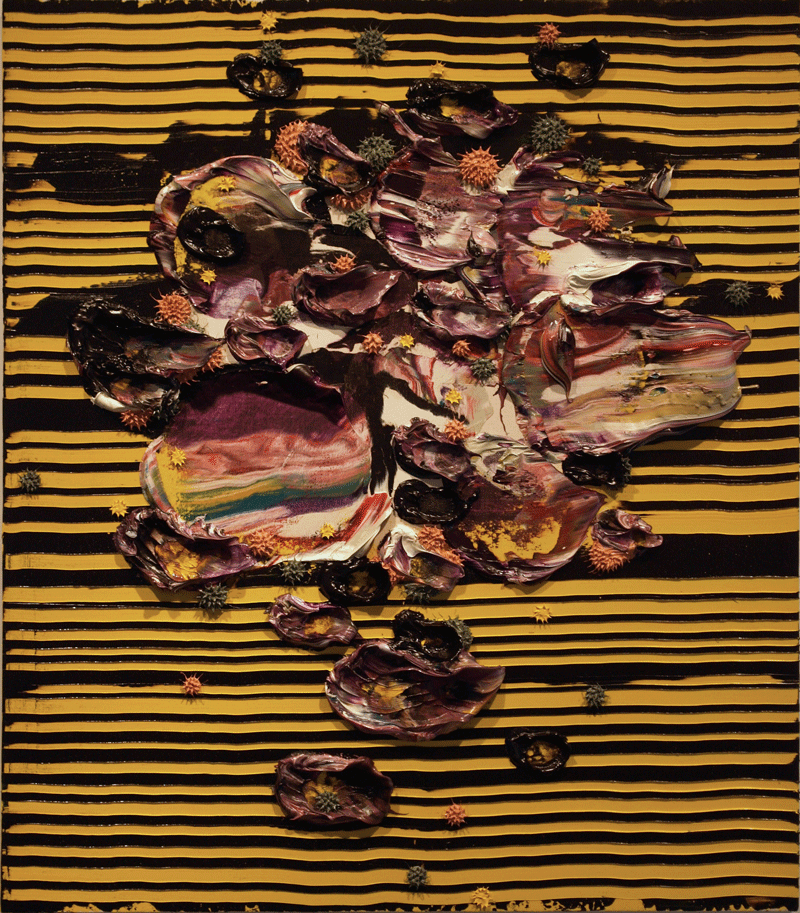December 25, 2009
Happy Holidays Everyone
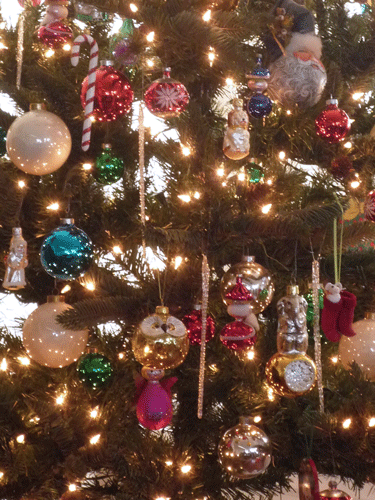
Before the sun sets, I have to send this out to everyone: Happy Holidays!
It's been several years since we spent xmas in Los Angeles.
It's sweet. Here's a shot of the backyard, Ahora style:
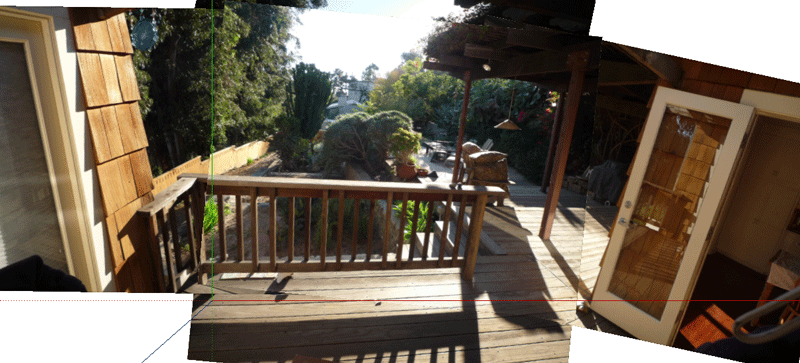
64?, partly cloudy, a faint breeze and sunny enough to still get a burn if you're not careful.
December 15, 2009
Whynot Purchase Art?

Andrew Hahn has been busy in the WPA printshop recently.
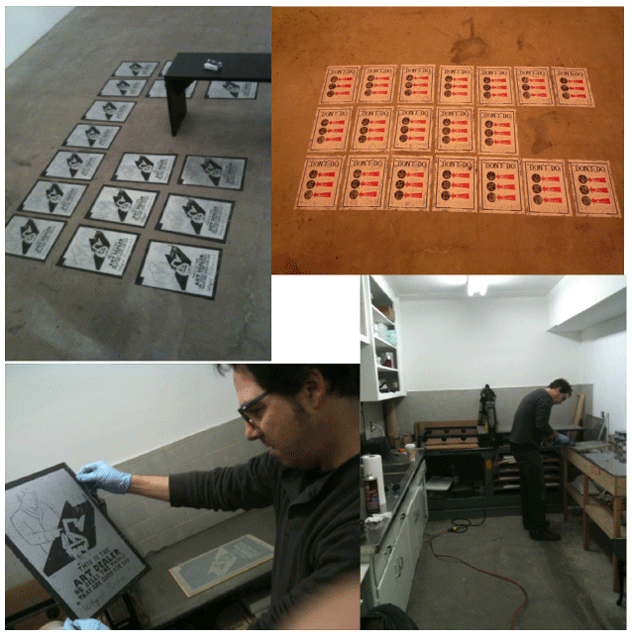
If I remember correctly, Andrew Hahn has printed an edition of ten separate prints, each a series of ten. They are ostensively apparent adverts for WPA, but in fact this is private artwork, to be made available to the art collector public during his upcoming show next spring.
Here are a couple of them:
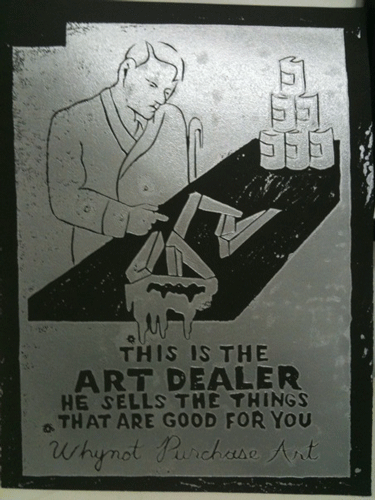

December 14, 2009
Soup Kitchen: WPA
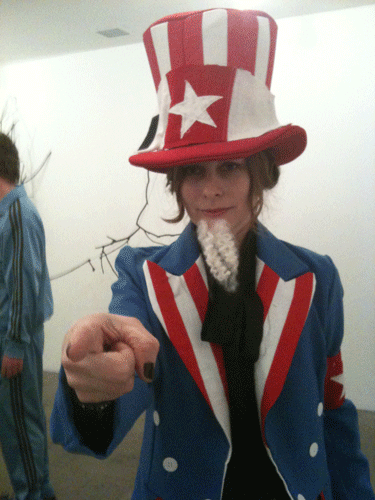
Uncle (Terri Philips) Sam wanted you to eat some soup. Artist collective gallery WPA had a closing show for Terri Philips last Saturday night, complete with several varieties of soup...
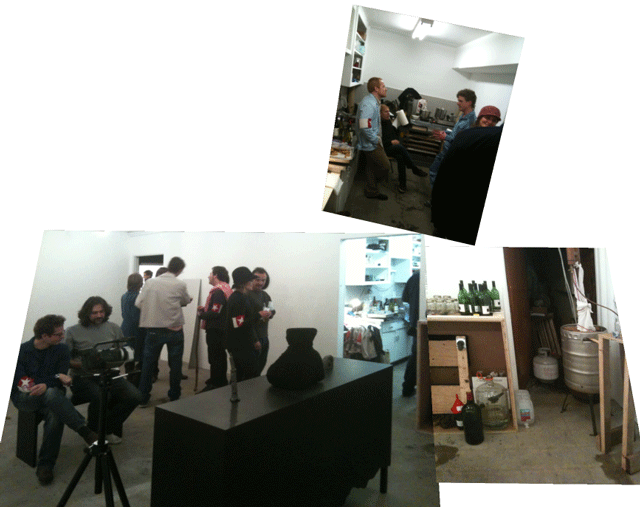
...and a moonshine still from Adam Janes to put some fire in the broth along the way.

December 11, 2009
trying to get there
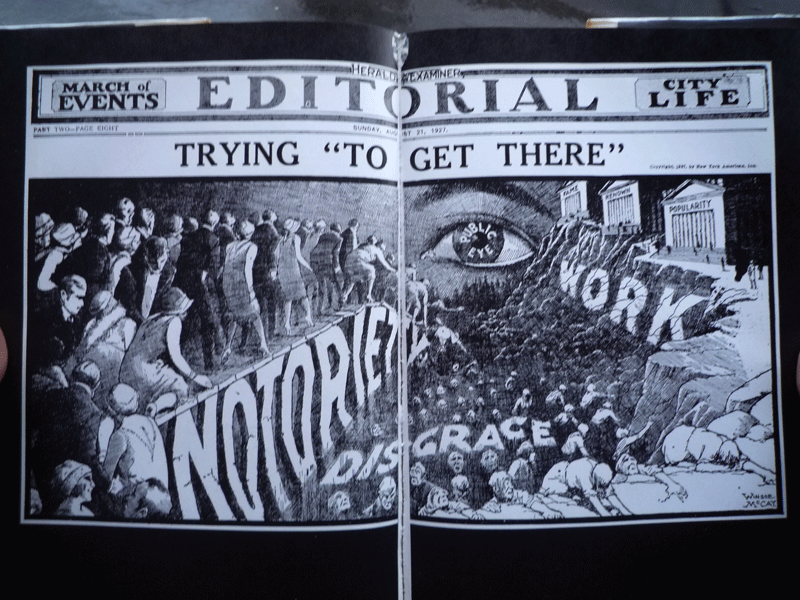
My Echo Park neighbor, writer and Otis kingpin Paul Vangelisti lent me Hollywood Babylon apropos a conversation we had "over the fence" of the daily news.
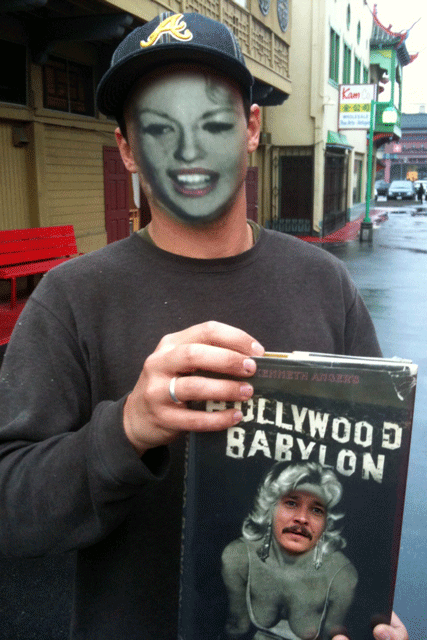
My ChinaTown neighbor Adam Janes told me all about Kenneth Anger and the artist who drew the cartoon, Winsor McCay. Very nice rabbit holes.
December 10, 2009
El libro de la Galer?a Miguel Marcos
My gallery in Barcelona has recently published a multi-volume book documenting the history of the gallery, "El libro de la Galer?a Miguel Marcos" which was presented las week in Barcelona. Here is some of the press about the event (the first one is in Spanish, the other in Catalan):
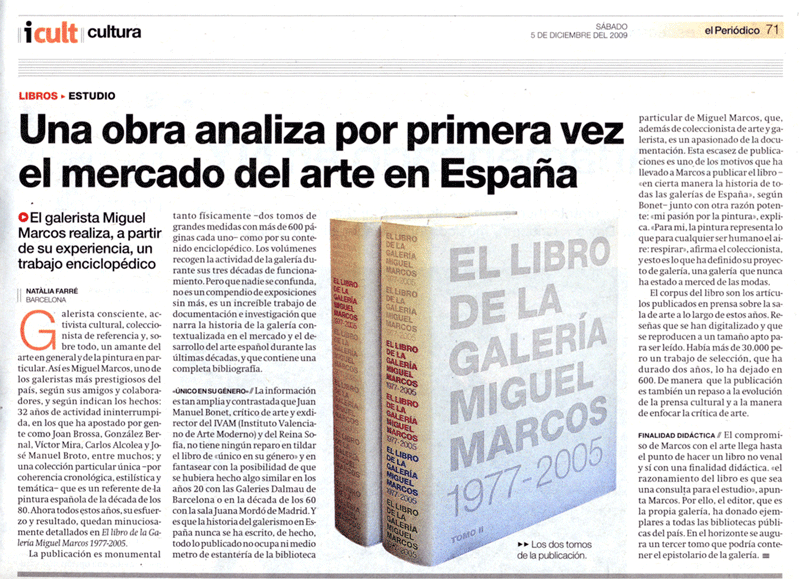
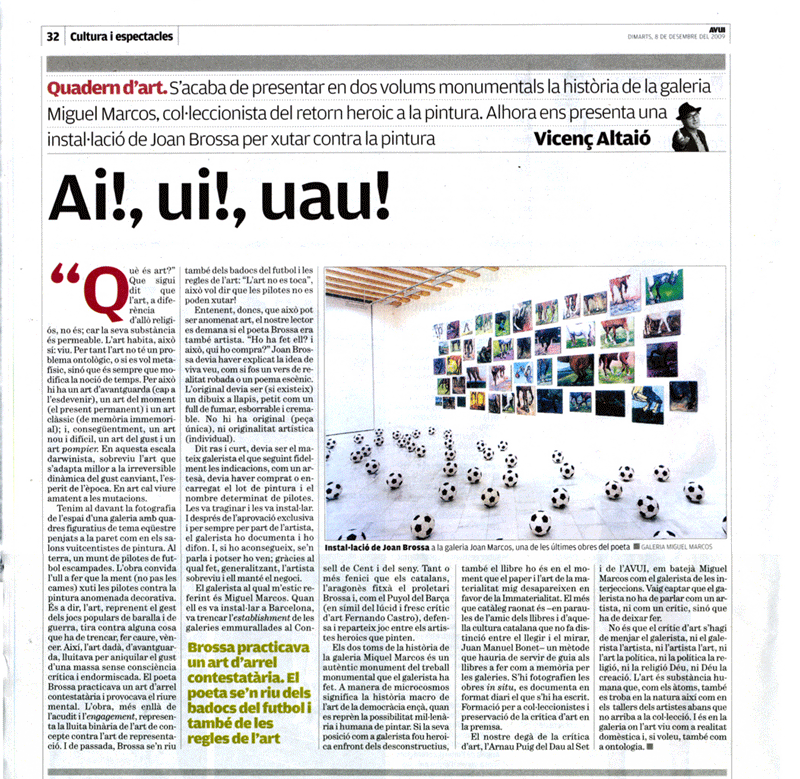
Adam Janes at Galerie Georges Philippe & Nathalie Vallois, Paris.

(Foto via iPhone app: iSwap Faces.)
Good Friend and ChinaTown studio neighbor Adam Janes opened a show at Galerie Georges-Philippe & Nathalie Vallois in Paris last week. I think I can talk him into giving an interview about it soon. Until then, here are installation shots he sent recently that I will share with you after the jump...
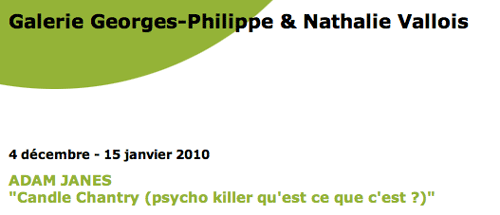
(By the way, the creature in Adam's arms is his little miss Bucket.)
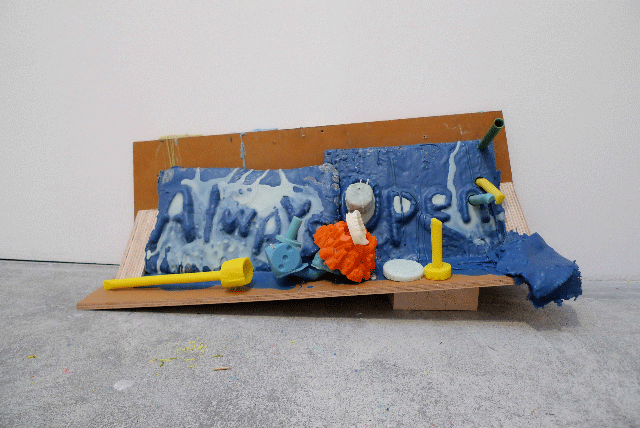


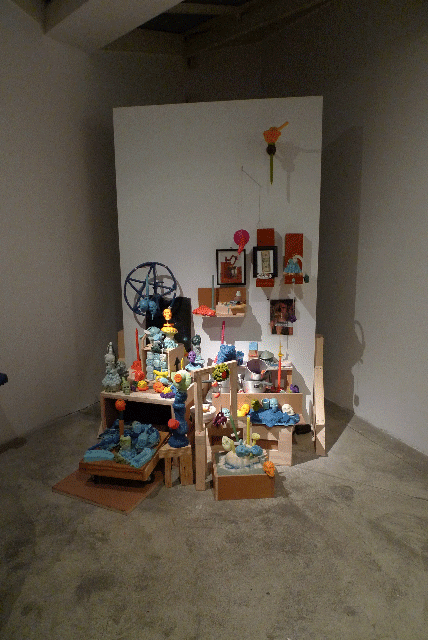
December 9, 2009
"...see how things work out."
Two Coats of Paint is rewarding as always, a favorite daily read. Sharon Butler got permission to reprint the first two chapters of A Painter's Life by K.B. Dixon. Here's my favorite excerpt from her excerpt:Coffee with Lewis Moore. Haven?t known him all that long. A still life painter, he got tired of the hard time he was having in New York so he moved out here, found a small place in the Pearl, and started letting himself go. Says he has put on fourteen pounds and developed a television habit?that he lives on Perry Mason reruns and pizza. He still hears from his old friends?one in particular named Zachary is trying to talk him into moving back. He says it would be better for Lewis as an artist and a person to live in New York, but Lewis isn?t interested. He says he likes living here. Says the Mayor was just arrested for drunk driving?or should have been. The fact that he wasn?t has gotten a lot of people upset. He wants to stay around to see how things work out.
I just bought it.
Notes on the Miami Art Fairs
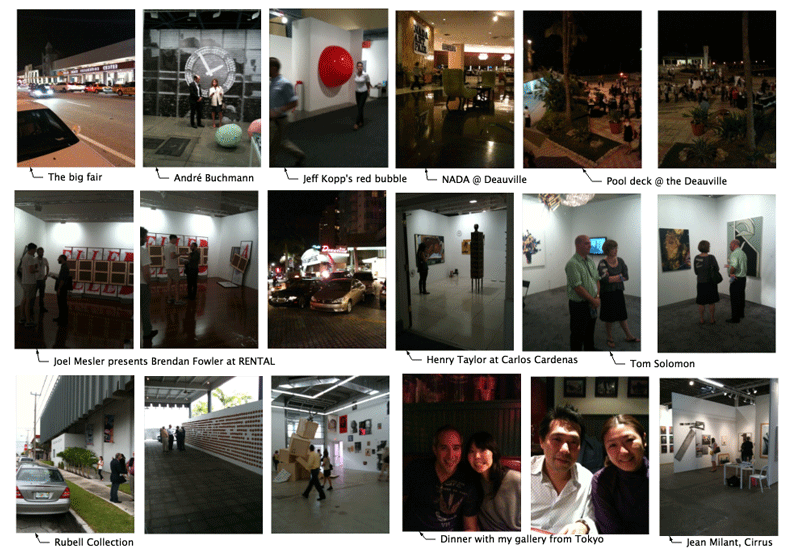
A smattering of photos and notes after my week in Miami...
And a smattering is all I can offer, my apologies to you dear reader. Being journalistic and systematic seems to get in the way of the flow through all the encampments of traveling art merchants that is the contemporary art fair. I was fortunate to be able to visit four of my galleries who were all together in the big fair of Art Basel Miami: Michael Kohn, Los Angeles; Nicole Klagsbrun, New York; Tomio Koyama, Tokyo; and Andr? Buchmann, Berlin. It was wonderful to catch up with them all in one site, the buzz and hum of the fair helping me jump in and out between their consultation with collectors.
I had estimated beforehand that a trip to Miami this year would enable me to gauge the health (biz-ness) of the art world and now I can report that all is well, everyone is surviving, everyone was selling enough work to more than justify the huge expense and risk of participating in the fairs. This is nothing triumphal to be sure, but what happened is surely not trenchant, as our struggling economic times seems to threaten. We've lived through earlier pops of the bubble, and it seems as if our art world has become strong enough to weather the storm, that the art marketplace is strong enough, integrated enough to promise viability and I hope, vitality as we rebuild our economic system anew. To those who flinch reflexively at the mention of filthy lucre, it is the welfare of thousands, perhaps millions of struggling artists who fight day in and out to carve out a life spent making art is what is important here. To wit:
?I must study Politicks and War that my sons may have liberty to study Mathematicks and Philosophy. My sons ought to study mathematicks and philosophy, geography, natural history, naval architecture, navigation, commerce, and agriculture, in order to give their children a right to study painting, poetry, musick, architecture, statuary, tapestry, and porcelaine.? John Adams, Letter to Abigail Adams, May 12, 1780.Art is crowning achievement of civilization, in other words.
Here then are a few impressions jotted down on the fly:
"Miami Basel as a space ship..." remarked one of my gallerists. As the big fair incorporated Positions (a special exhibition of emerging art shown in several shipping containers by the beach in earlier fairs) into the Miami Beach Convention Center, the showcase resembled the hermetic interiority of a vast space ship, especially with the solitary vista of the painted (NASA) blue of the space frame (a technical architectural term of art) overhead. Experience of greater Miami for these exhibitors was limited to something resembling a tropical EVA, especially with the strong weather system that hung over Miami that week, as swelteringly humid and pocked with showers as it was. This was Miami for these prime art booth denizens: long duration flights, twelve hour days within the space ship, a veritable Silent Running complete with the feeling of disorientation adrift within the fair architecture.
Up against this, was the triumph of NADA, the anti-space ship. With its seaside location and Collins Street frontage, this fair at the Hotel Deauville was Miami verdadero, the chipped warm grey paint of the hotel rooms offset by limestone bathroom floors, ample accomodations and leather upholstered headboards. It was a distillation of hip, still resonant with the legendary 60's visit of the Beatles. I had expected NADA to be the locus of the party scene but time and time again the hotel couldn't sustain critical mass since so many other competing private parties drew the festival goers to other parts of Miami. It was stranger still to find that this fair's bureaucrats had denied entrance at the big party to several friends who I would have expected to be considered VIP's, but no worries, a local bar across the street called the Sand Club (complete with several inches of beach sand adorning the floor) served as a ready sanctuary for an impromptu alternate party site for them. Much fun was had, it was for me the best party of the week.
(Update: I learned long afterwards that the Miami fire marshals limited the number of people who could attend the party, no fault of the NADA organizers. NADA has a good reputation and I never meant to cast aspersions on them. )
The only bright light at the Scope Art Fair was Jean Milant's Cirrus gallery, who also did well in Miami. The organizers of this fair should have attended to the multitude of showcase infractions: a confused and desultory entrance rimmed with chain link fence topped with concertina wire, dying grass sod despite the recurrent showers, the litter of installer's equipment (scissor lifts, carts, ladders) decorated with trash here and there. A fair that relies on portable tent structures should compensate with an impeccable presentation.
One comment from a gallerist stayed with me: about how tough it was to respond to a collector who wanted to know immediately about the resale value of an art object in question. Ah, art as investment! It occurred to me that we have a nice paradox here: that the value of an artwork depends on one's unwillingness to part with it. If a collector buys a piece with a desire to transact a profit, then the value of the piece will be diminished. If one is fundamentally unwilling to part hands with it, its' value will be enhanced. The more one wants to cash in on the exchange value, the less valuable the art object in question is. This is the stuff of Zen Koans! This is how the extrinsic value of art stems from an intrinsic one (and this begins with the artist as the first audience). Anyone who wants to make a killing in art-as-investment should first be personally, deeply invested both emotionally and intellectually -or get out of the game.
I heard recurrent commentary from several quarters about the problem/promise of the private museum situation in Miami, that the city should have a public space for contemporary art, that the city is building one at the moment but that they don't have have yet the money for a permanent collection but also that they have not yet raised sufficient funds for the architecture. (I have yet to research this, by the way, so I can't confirm how much of it is true.) An acquaintance from Manhattan mentioned this to me along the way, and I suggested that even New York's art world history was primed by a community of private museums. Perhaps this is the normal gestation for a MOMA/MOCA Miami too.
This brings up the problem/promise of insider trading. The specter of conflict of interest hovers over our vast art world. I remember one particular/peculiar character I knew once long ago in this art world who once described the contemporary scene as "legal insider trading". It was cynical notion to be sure, and it is most certainly important to condemn it, but against this jaundiced view it might be interesting to consider that the entirety of the art world is, first and foremost, an art marketplace in the virtuous sense of the term. Is it possible that the art world as we know it began with Kahnweiler? (I would be interested in reading something about the history of art as a marketplace, has anyone written such a thing? Is it true that academia is profoundly not only uninterested but hostile to the thought?). The economic spark of our art world is driven by the sale of emerging artists and sustained by the investment in established artists (and in between hang the mid-career artists by tender hooks). There was mention here and there of the recent controversy concerning Jeff Koons and New York's New Museum, an issue I am not up on at this moment. What little I learned about it last week brought to mind the movie Casablanca and the theme of redemption despite soiled hands that the casting of Humphrey Bogart represented at the time for wartime America. Amidst a fallen world, there was the need for the dark hero who could navigate the hazards that the ethically pure could not... and the hope that the morally ambiguous hero/anti-hero might do the right thing when the final curtain fell.
December 1, 2009
MiamiBasel
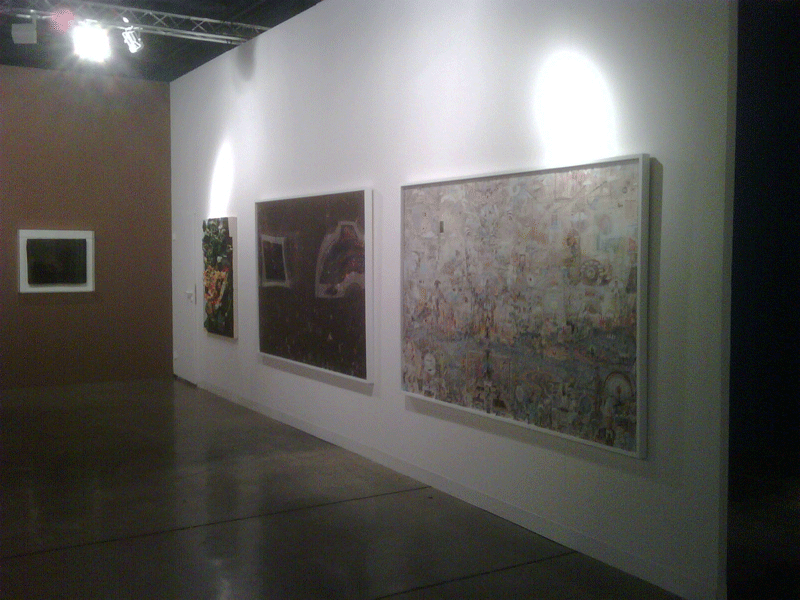
I'll be flying out to the art fairs in Miami today. My peeps at Michael Kohn Gallery sent in these pics of the install this morning. Next to my painting Johnny Jump Up (#319), are two pieces from Simmons & Burke. I'll get to visit two of my other galleries, Nicole Klagsbrun and Tomio Koyama, who will also be exhibiting at Art Basel/Miami as well.
I decided to use FaceBook for the minute to minute impressions, so tune in if you get a chance...
